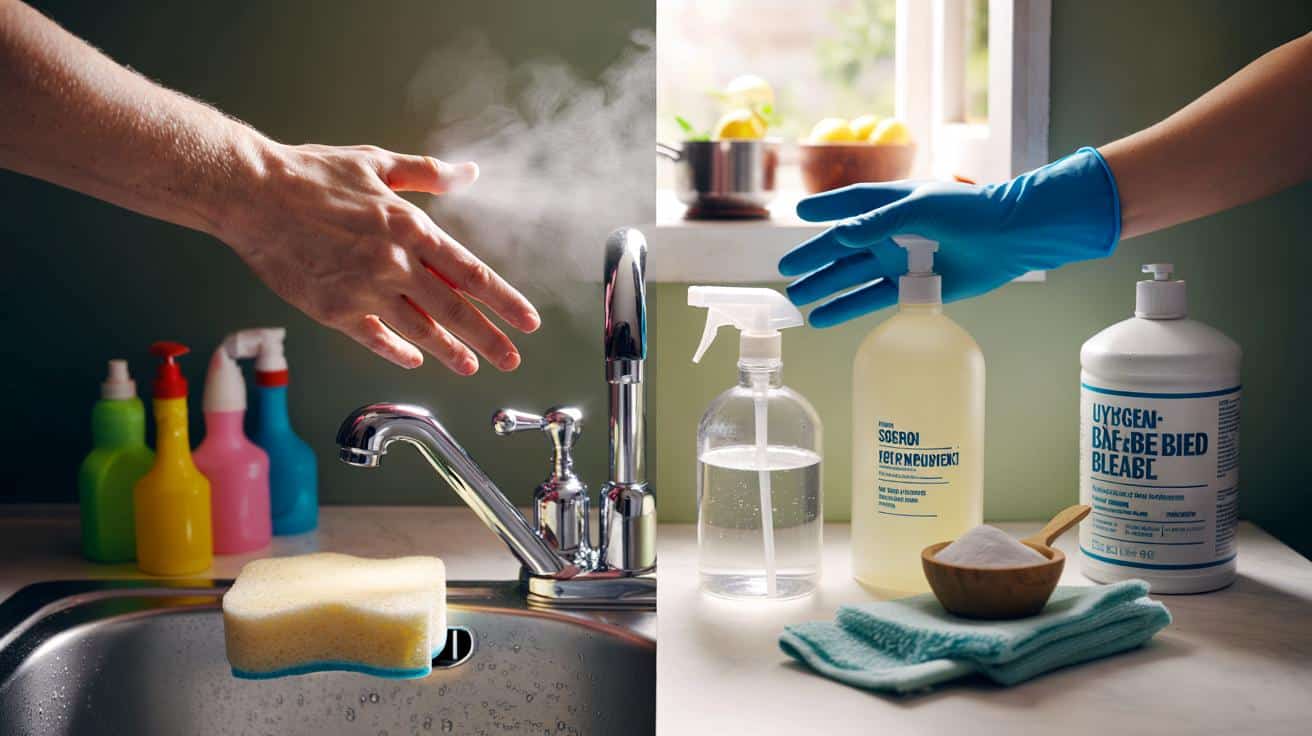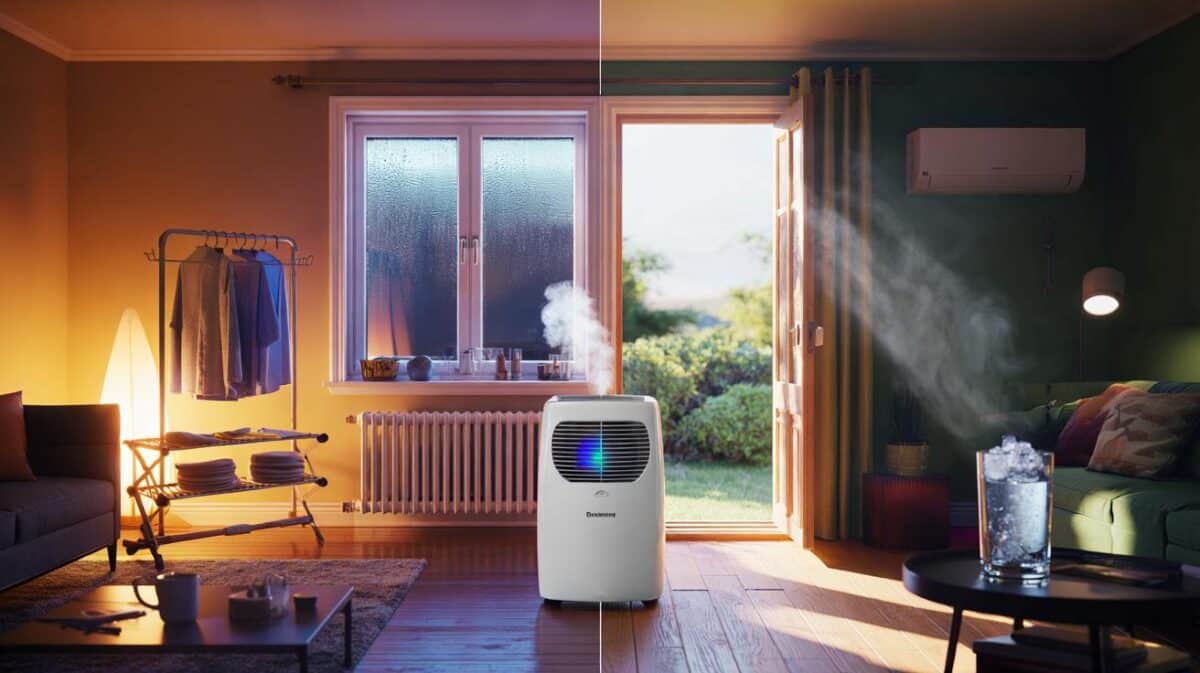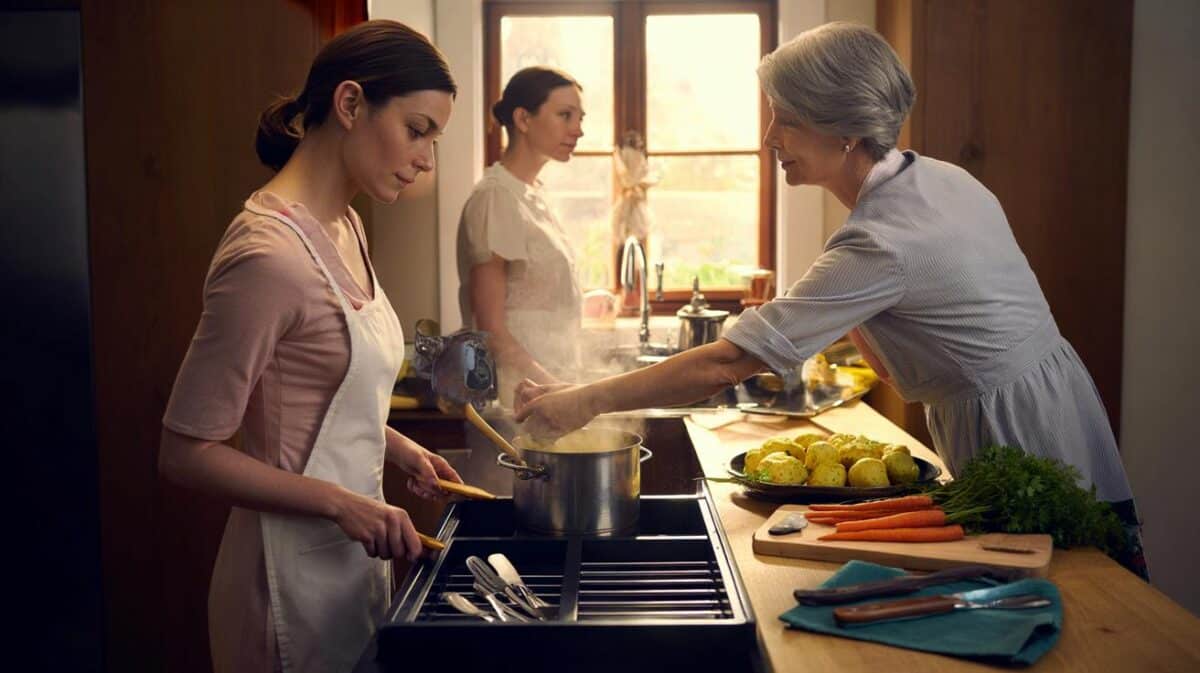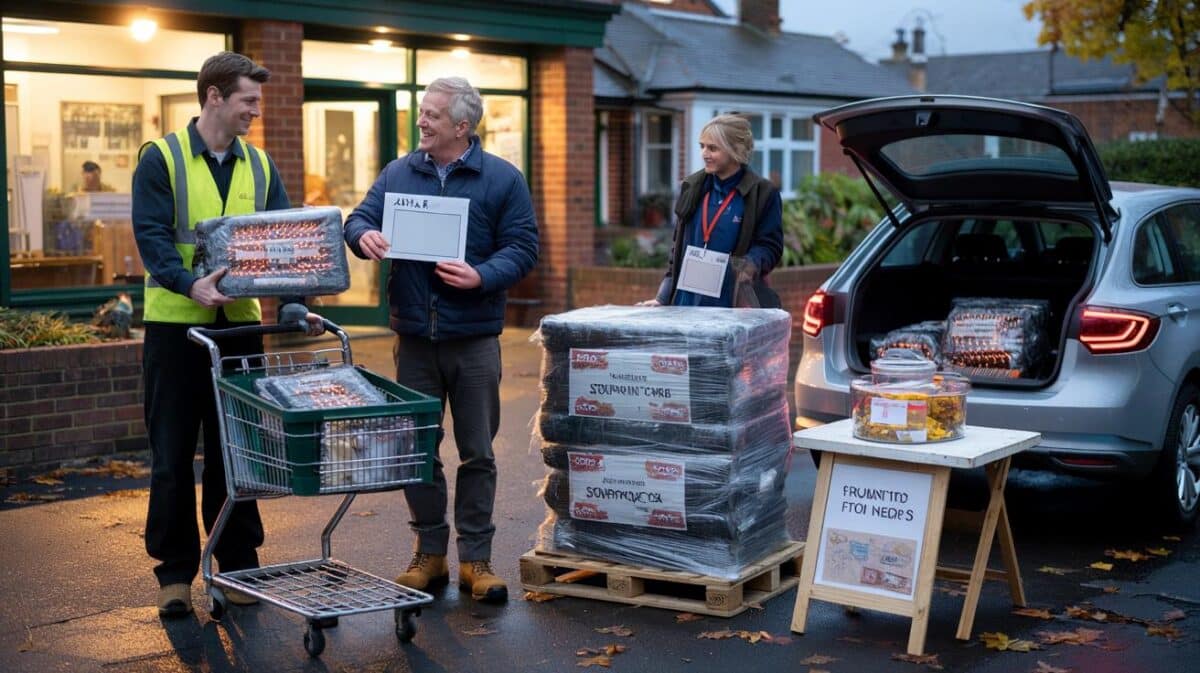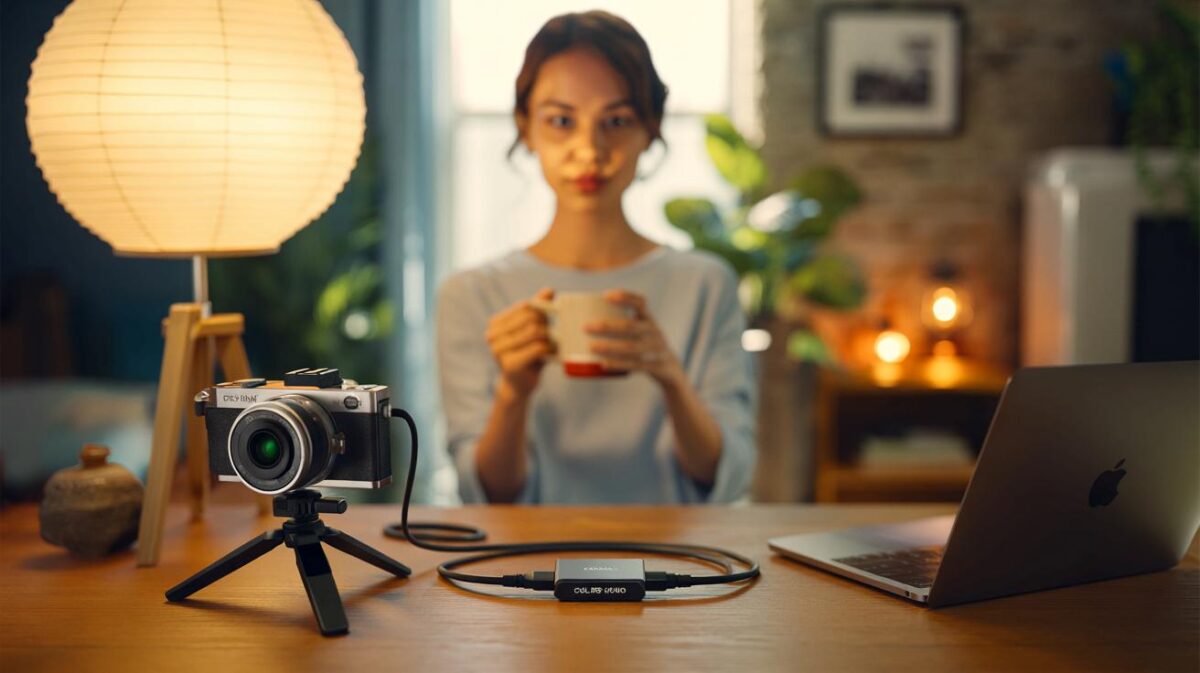The products that make your home sparkle can quietly rough up your skin. Harsh surfactants, high or low pH, lingering disinfectants and punchy perfumes can strip your barrier, trigger rashes, and keep irritation smouldering long after you’ve finished scrubbing. The good news: small swaps change everything.
Two sprays and the kitchen filled with that hotel-lobby smell. The worktop gleamed, the taps flashed clean, and my hands kept moving, autopilot tidy-mode switched on.
Twenty minutes later, the skin between my fingers felt oddly tight. An hour after that, it prickled like a wool jumper under a heat lamp. By bedtime, faint red maps had crept across my knuckles. I’d cleaned the house. My hands had paid the price.
The next day I tried the same job with a gentler product and gloves. No sting, no map, same shine. The lesson arrived quietly.
The quiet sting behind a spotless sink
We scrub because clean spaces relax the brain. Red hands don’t. A lot of everyday sprays, gels and wipes are stacked with strong surfactants that lift grease by lifting your natural oils too. Strip the lipids, and the “mortar” between skin cells loosens, so water escapes and irritants sneak in.
*Your skin is the first surface in your house.*
We’ve all had that moment when you rinse a sponge, turn the tap, and realise your fingertips feel like paper. It’s not just the act of scrubbing. It’s the chemistry clinging to your hands after the job is done. Quats sit on surfaces, fragrances linger in air, and your skin stays in contact for hours.
The numbers are sobering if you dig. Dermatology clinics see spikes in hand dermatitis after cleaning binges and moving days, and the UK’s Health and Safety Executive lists cleaning among the higher-risk tasks for contact dermatitis. Fragrance mixes and preservatives like isothiazolinones have a track record for triggering allergy. Bleach, acids and solvent blends don’t need an allergy to hurt; they’re irritants by design.
One parent I spoke to noticed her son’s bath-time rash faded the week she swapped the pine-perfumed bathroom spray for a fragrance-free cleaner. No pills, no creams, just a quieter ingredient list. It felt almost too easy. That’s the point.
Think of cleaners across three stressors: pH, potency, persistence. Bleach and oven gels sit at the extremes of pH, so they disrupt proteins and lipids fast. Strong degreasers cut fat on pans and the fat in your skin barrier, too. Disinfectants like quats don’t just vanish; they’re designed to hang around, which means your skin keeps meeting them long after the mop is back in the cupboard.
Safer swaps you can actually live with
Start with the daily jobs. Switch fragranced all-purpose sprays for **fragrance-free** versions with short ingredient lists. For glass and splashbacks, try a 1:1 mix of white vinegar and warm water with a single drop of mild dish soap in a trigger bottle, then buff with microfibre. Grease on the hob? A teaspoon of bicarbonate of soda plus a little liquid soap makes a paste that lifts without burning your hands.
For floors, a cap of gentle, dye-free detergent in a bucket of warm water is enough for regular dirt. Disinfect only where it matters: toilet, bin, chopping boards after raw meat. When you do need disinfecting, lean on time and coverage more than brute strength. **Dilute, don’t douse.** Rinse when the label says rinse. Moisturise straight after you wash your hands—plain, unscented cream. Let’s be honest: no one actually does this every day.
Common missteps trip the best of us. Spraying extra “for luck” raises residue and risk, not hygiene. Mixing bleach with vinegar or limescale removers creates a dangerous gas, and mixing bleach with ammonia creates chloramines—never combine. Hot water inside rubber gloves can turn them into tiny saunas and worsen irritation; switch to cotton liners or take short glove breaks. **Nitrile over latex** if you’re sensitive or your hands sweat.
“Healthy skin is a better defence than any disinfectant,” a consultant dermatologist told me. “If a product stings, your barrier is already telling you it’s not coping.”
- Bleach for grout? Try oxygen bleach powder, let it sit, scrub, rinse.
- Quats wipes? Soap, water, a 5-minute contact time, then dry.
- Perfumed air sprays? Open windows; boil lemon peels for scent.
- Cream cleansers? Bicarbonate paste plus soft cloth.
- Solvent degreasers? Diluted dish soap and hot water, repeat once.
Rethink the shine: your skin-first cleaning routine
There’s a calmer way to clean that doesn’t leave your hands buzzing. Map your week: touch-up cleans on most days using microfibre and warm water; targeted products for true grime. Keep one bottle each of a neutral pH, fragrance-free all-purpose cleaner, a gentle dish soap, and a specific disinfectant for toilets and bins. Label them, decant them, and store gloves right beside them so the ritual becomes automatic.
Track what triggers your skin for a fortnight: product, task, time to tingle. Swap one thing at a time so you know what works. If you share a home, set house rules for sprays in small rooms—doors open, fan on, less is more. Buy smaller bottles; they’re easier to handle with gloves, and you’ll use them up before ingredients go weird. A hand cream by every sink beats good intentions. Tiny changes, big difference.
Your home won’t be less clean. It will just be kinder. A quiet surface, a quiet sink, and hands that don’t hum after the job is done. That’s the sort of clean you can feel proud of and live with.
| Key points | Detail | Reader Interest |
|---|---|---|
| Harsh chemistry strips skin | Strong surfactants, extreme pH and persistent disinfectants weaken the barrier | Explains the “mystery rash” after cleaning |
| Simple swaps work | Fragrance-free cleaners, vinegar mixes, oxygen bleach, microfibre, time | Practical steps you can try today |
| Protect the process | Nitrile gloves, cotton liners, rinse residues, moisturise after | Keeps hands comfortable without extra effort |
FAQ :
- Which cleaning ingredients are most likely to irritate skin?High or low pH agents (bleach, oven cleaners, descalers), strong surfactants, quaternary ammonium compounds, solvents, fragrance mixes, and certain preservatives like isothiazolinones.
- Are “natural” or eco products automatically safer for skin?Not automatically. Some plant oils and essential oils can irritate or cause allergy. Choose fragrance-free, dye-free, neutral pH products and short ingredient lists over vague “natural” claims.
- What gloves protect without making my hands sweat?Lightweight nitrile gloves with breathable cotton liners. Swap pairs during long jobs, and let hands dry fully before putting them on again.
- Can I disinfect without quats or splashy bleach?Yes. Soap and water plus contact time removes many microbes. For targeted disinfection, use diluted bleach correctly or hydrogen peroxide-based products, then rinse if labels require.
- My eczema flares after cleaning—what should I change first?Cut fragrance, switch to neutral pH, wear nitrile gloves with liners, reduce disinfectant use to high-risk areas, and moisturise after washing. If flares persist, speak to a GP or dermatologist.
